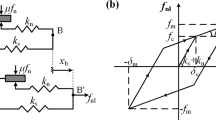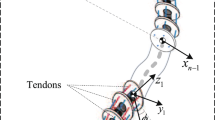Abstract
Hydraulic actuators are important in modern industry due to high power, fast response, and high stiffness. In recent years, hybrid actuation system, which combines electric and hydraulic technology in a compact unit, can be adapted to a wide variety of force, speed and torque requirements. Moreover, the hybrid actuation system has dealt with the energy consumption and noise problem existed in the conventional hydraulic system. Therefore, hybrid actuator has a wide range of application fields such as plastic injection-molding and metal forming technology, where force or pressure control is the most important technology. In this paper, the solution for force control of hybrid system is presented. However, some limitations still exist such as deterioration of the performance of transient response due to the variable environment stiffness. Therefore, intelligent switching control using Learning Vector Quantization Neural Network (LVQNN) is newly proposed in this paper in order to overcome these limitations. Experiments are carried out to evaluate the effectiveness of the proposed algorithm with large variation of stiffness of external environment. In addition, it is understood that the new system has energy saving effect even though it has almost the same response as that of valve controlled system.
Similar content being viewed by others
References
AHN, K. K. and Tu, D. C. T., 2004, “Improvement of the Control Performance of Pneumatic Artificial Manipulator using Intelligent Switching Control Method,” inKSME, Int. Journal, Vol. 18, No. 8, pp. 1388–1400.
AHN, K. K., 2004, “Development of Force Reflecting Joystick for Hydraulic Excavator,”JSME Int. Journal, Series C, Vol. 47, No. 3, pp. 858–863.
Andersson, J., Krus, P. and Nilsson, K., 1998, “Optimization as a Support for Selection and Design of Aircraft Actuation Systems,”In Proc. of the Seventh AIAA/ USAF/NASA/ISSMO Symposium on Multidisciplinary Analysis and Optimization, St. Louis, USA, September 2–4.
Andersson, J.,2002,“Sensitivity analysis in Pareto optimal design,”Proc. of the 4th Asia-Pacific Conf. on Simulated Evolution and Learning, SEAL 02, Singapore, November 18–22.
Andersson, J., Krus, P., Nilsson, K. and Storck, K., 1999, “Modelling and Simulation of Heat Generation in Electro-Hydrostatic Actuation Systems,”In proc. of the 4:th JHPS Int. Symposium on Fluid Power, Tokyo, Japan, November 15–17.
Andersson, J., Krus, P. and Wallace, D., 2000, “Multiobjective Optimization of Hydraulic Actuation Systems,”In Proc. of ASME Design Automation Conf., Baltimore, USA, September 11–13.
Andrew Alleyne and Rui Liu, 2000,“A Simplified Approach to Force Control for ElectroHydraulic Systems,”Control Engineering Practice 8, pp. 1347–1356.
Ha, Q. P., Nguyen, Q. H., Rye, D. C. and Durrant-Whyte, H. F., 2001, “Fuzzy Sliding-Mode Controllers with Applications,”IEEE Trans, on Industrial Electronics, Vol. 48, No. 1, pp. 38–46.
He, S. and Sepehri, N., 2000,“Online Modeling and Prediction of a Hydraulic Force-acting System Using Neuron Networks,”IEEE Int., Conf, on Systems, Man, and Cybernetics, pp. 2661 -2672.
Hung-Ching Lu and Wen-Chen Lin, 1993,“Robust Controller with Disturbance Rejection for Hydraulic Servo Systems,” IEEE Trans, on Industrial Electronics, Vol. 40, No. 1, pp.157–162.
Jörg GRABBEL, 2000, “On the control of joint integrated servo actuators for mobile handling and robotic applications,”Proc. of 1 st FPNI-PhD Symp.Hamburg, pp. 449–465.
Laurent Laval, Nacer K. M’Sirdi and Jean-Charles Cadiou, 1996,“∞ Force Control of a Hydraulic Servo-Actuator with Environment Uncertainties,”Proc. of the 1996 IEEE International Conf. on Robotics and Automation, pp. 1566–1571.
Navid Niksefat and Nariman Sepehri, 1999,“-Robust Force Controller Design for a Hydraulic Actuator Base on Experiment Input-Output data,”Proc. of the American Control Conf., San Diego, California.
Rahmfeld, R. and Ivantysynova, M., 2001,“Displacement Controlled Linear Actuator with Differential Cylinder—A Way to Save Primary Energy in Mobile Machines,”5th Int., Conf, Fluid Power Transmission and Control (ICFP’ 2001), Hangzhou, China, S. 296–301.
Yen, Y. and Lee, C., 1992,“Robust Speed Control of a Pump Control Motor System,”IEE Proc. -D, Vol. 139, No. 6, pp. 503–510.
Author information
Authors and Affiliations
Corresponding author
Rights and permissions
About this article
Cite this article
AHN, K.K., Chau, N.H.T. Force control of hybrid actuator using learning vector quantization neural network. J Mech Sci Technol 20, 447–454 (2006). https://doi.org/10.1007/BF02916475
Received:
Revised:
Issue Date:
DOI: https://doi.org/10.1007/BF02916475




